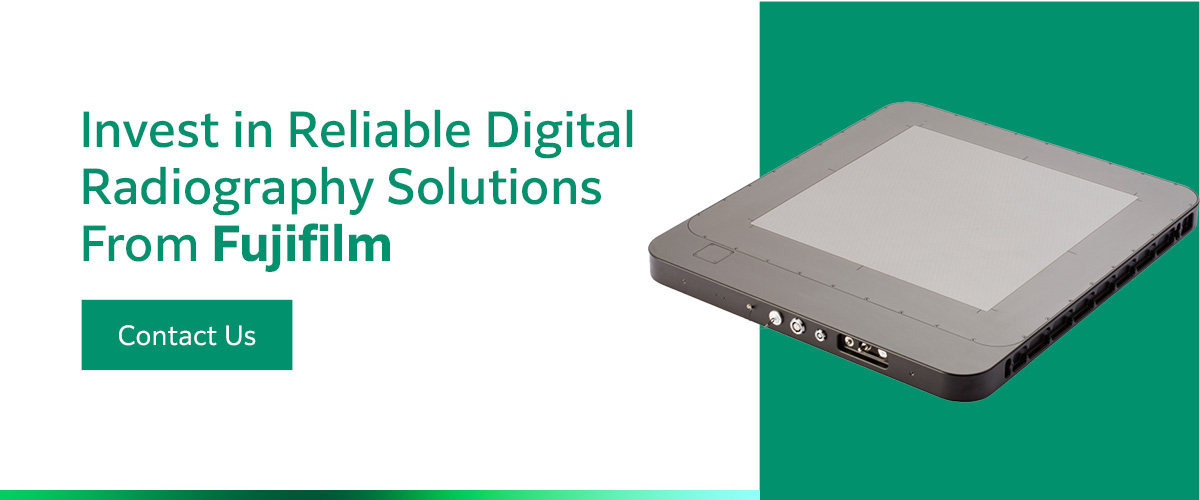What Are Digital Detector Array Panels?

Industries like energy, aerospace and manufacturing must meet specific standards for quality and safety in their work. But, staying compliant while avoiding equipment damage is challenging. These industries need efficient, safe testing methods to meet regulatory standards.
Non-destructive testing (NDT) processes ensure testing accuracy without leaving damage behind. Radiography, or X-ray testing, is a common NDT method. However, traditional X-ray testing is limited in its abilities. Digital detector array (DDA) panels are an advanced version of X-ray testing. This digital radiography delivers high-resolution imaging that makes inspections faster and more precise.
What Is a Digital Detector Array?
Digital detector arrays, or flat panel detectors, elevate X-ray technology for specialized applications. A DDA produces real-time imaging results, meeting high-volume manufacturing testing needs without compromising production. DDAs convert X-rays into digital signals so users can immediately see accurate component information in a noninvasive analysis. Digital radiographic testing is a highly effective technology for spotting corrosion, structural flaws and material irregularities.
Since DDAs are digital, they make technicians’ jobs easier. NDT and quality assurance specialists can save, analyze and share testing results as needed. This process speeds up initial testing and streamlines information sharing, improving production efficiency.
How Do DDA Panels Work?
DDA panels are a critical part of NDT. As mentioned, DDAs convert radiation into digital signals. When X-rays pass through the subject material, the DDA panel absorbs them. The unique absorption pattern produces detailed images that display internal structures and flaws.
More specifically, the DDA panel takes X-rays and turns them into readable light signals. X-rays pass through the object, hitting the DDA panel. The X-rays become light signals, which are read by a photodiode layer. The light readings have different intensities based on where they passed through. The more intense the light, the higher the electrical charge it generates in each photodiode. The DDA then reads these electrical charges as digital pixels, creating a highly detailed image.
There are two types of DDA panels: Stationary and portable:
- Stationary NDT panels: Stationary or fixed NDT panels are larger than portable models. They’re often installed in fixed locations like in-house inspection labs or on manufacturing floors. Products are brought in for testing to the panel. Their size makes them ideal for inspecting large item quantities in controlled settings.
- Portable NDT panels: Portable or mobile NDT panels are compact and lightweight for fieldwork. They work effectively in situations like inspecting pipes on-site, where you require accurate images in hard-to-reach areas. They’re just as accurate as stationary models, but their portability means lower-volume outputs.
Advantages of Digital Radiographic Testing Over Traditional Radiography

Digital testing methods, like DDAs, offer several advantages over traditional methods. While traditional radiography provides accurate results, it’s much slower and harder to transport. Using traditional methods can slow testing and production down, increasing costs long-term. Some benefits of DDAs include:
- Real-time imaging: Traditional methods need time to develop images. DDAs provide real-time imaging — you get instant image capture and viewing. With no film processing period, technicians can start assessing immediately.
- Immediate analysis: Real-time imaging means immediate analysis. Technicians can adjust or enhance the digital images to highlight specific areas or identify small defects. This rapid analysis is essential for quality analysis since users need fast, accurate results to move forward.
- Portable: DDAs also come in portable options. Traditional film setups require fixed equipment. Conversely, portable DDA systems allow for remote field inspections, reducing time spent on analysis and logistical planning.
- Cost-effective: DDAs offer greater cost-effectiveness. Digital imaging eliminates the need for film and chemical processing, reducing material costs and environmental waste.
Applications of Digital Radiography in Various Industries
Digital methods like DDAs and computed radiography have transformed NDT across dozens of industries. DDAs have raised quality assurance and safety standards through their rapid, detailed insights. With digital radiography, technicians can easily capture and analyze high-resolution images. Industries that require accurate quality control measures for high-use components can rely on DDAs for safe, effective quality compliance.
- Aerospace: Aircraft engineering demands rigorous testing to ensure passenger safety and structural integrity. Technicians use DDAs to inspect aircraft materials, like composite structures, for signs of fatigue or crack development. DDAs can reveal internal cracks or defects in components like wing panels, finding issues before they affect safety.
- Oil and gas: Portable DDAs support better pipeline inspections and structural assessments. DDAs highlight cracks, corrosion and defects in industry parts. The real-time imaging technology easily captures images in remote or tight areas. Technicians can identify flaws on-site, reducing hazards.
- Automotive: The automotive industry leverages DDA technology to inspect components like welds, transmission systems and engine parts. This technology allows technicians to adjust images and ensure every part meets regulations.
- Manufacturing: DDAs also support better quality control in manufacturing. Similar to other industries, DDAs can detect issues in welds and castings in real time. Manufacturers can employ DDAs to maintain strict product standards without slowing down production.
- Construction: The construction industry uses DDAs to inspect structural components. Concrete, steel and welded joints all need to be assessed to ensure structures are safe and durable. Portable digital imaging easily spots internal flaws, making on-site inspections more efficient.
Choosing the Right DDA Equipment
While DDAs play a key role in quality control, finding the right model for your needs can be challenging. NDT and quality assurance specialists should consider these factors when exploring DDA specifications:
- Resolution and image quality: Choose high-resolution systems for applications that need extreme attention to detail. Different DDAs offer resolution options. High resolutions demand more powerful processing, which might be incompatible with your current software. Users must balance resolution requirements with their current capabilities.
- Portability: You’ll need to choose between portable or stationary DDAs. Select portable models for inspections that occur mainly in the field or remote locations. These situations call for lightweight, mobile DDAs.
- Inspection area: Larger detectors, like stationary DDAs, can cover extensive areas in one scan. Users working on aircraft components or heavy equipment should look to large, stationary models. Smaller detectors can offer more precise imaging but often require multiple scans for large objects.
- Budget: Budget will always impact your DDA equipment selection. Operations should balance imaging and durability with their existing budget. Avoid sacrificing essential resolution capabilities for money since quality systems can provide better long-term reliability. Our Dynamix FXR and FXR Pad balance cost and functionality, delivering quality and durability across price points.
Invest in Reliable Digital Radiography Solutions From Fujifilm
When it comes to NDT, the right DDA system can make all the difference. Elevate the safety, accuracy and efficiency of your inspections with Fujifilm’s advanced DDA solutions. Our products are engineered to meet the diverse needs of various industries. Enjoy real-time, high-resolution imaging with portable and stationary options so you can find a solution tailored to your needs.
By choosing Fujifilm, you gain access to state-of-the-art NDT technology. We develop all our solutions with an unmatched commitment to quality and innovation. Our DDAs offer industry-leading performance and elevated quality assurance standards for your team. Reach out to Fujifilm today to learn more about our products and find the right technology for your business!











